“Warhead”
Written by Brannon Braga and Michael Taylor & Kenneth Biller
Directed by John Kretchmer
Season 5, Episode 25
Production episode 219
Original air date: May 19, 1999
Stardate: unknown
Captain’s log. For the fourth night in a row, Kim is in charge of gamma shift. He and the conn officer, Ensign Jenkins, banter for a bit on the subject of how seriously one should take the overnight shift, when they receive a distress call. Kim orders a course change toward the call to discover that the planet it comes from has no lifesigns.
Kim wakes Chakotay, who assures him that he did the right thing, and then offers to let Kim lead the away team. An eager Kim beams down with a security guard, Lang, and the EMH. They discover no life, but they do find a device that communicates in a language that the EMH’s translator matrix can translate, but the universal translators in everyone else’s combadges can’t for reasons the script never bothers to explain.
The device is an AI, but it doesn’t seem to know who or what it is—or even that it’s a device rather than a person. The EMH talks to it, and he convinces Kim that they should beam it back to the ship to try to help it restore its memories. Kim then convinces Janeway and Chakotay to do so, beaming it into engineering with a level-ten containment field.
One thing the device remembers is that it had a companion. Janeway and Seven scan for this companion in astrometrics while Torres, Kim, and the EMH try to restore the device’s memory. After determining that it’s safe, they transfer the device to sickbay with the object of trying to create a holographic matrix to put the AI in.
Janeway and Seven find the companion, or, more accurately, its impact: it crashed into the surface and exploded.
It soon becomes clear that these two devices are weapons of mass destruction. Janeway calls a meeting to discuss what is to be done with it. The device doesn’t remember its function, and it’s a sentient being. The EMH pleads for the AI to be extracted from the weapon as planned. Janeway agrees, however when they try to implement this plan, the AI realizes what they’re doing and interprets it as an attack, arming itself. The EMH tries to convince it to disarm, but it’s having none of it, so Janeway orders Torres to shut it down with an EMP.
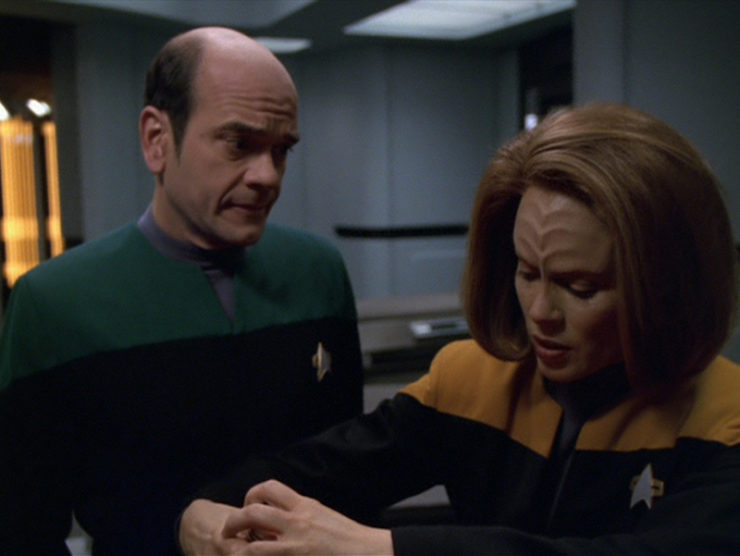
That works, but the AI transferred itself out of the warhead and into the EMH’s mobile emitter before the EMP hit it. Now it has taken over the doctor’s ambulatory form and sealed off sickbay, trapping Torres and Kim in there with it, and keeping everyone else out.
The AI has its memories back, at last: it’s a warhead created by the Druoda for their war against the Salinians. Its mission is to attack a military installation on Salina Prime and destroy it. It intends to fulfill that mission, and instructs Janeway to set course for Salina Prime. If she doesn’t, it will arm itself and destroy the ship.
Buy the Book
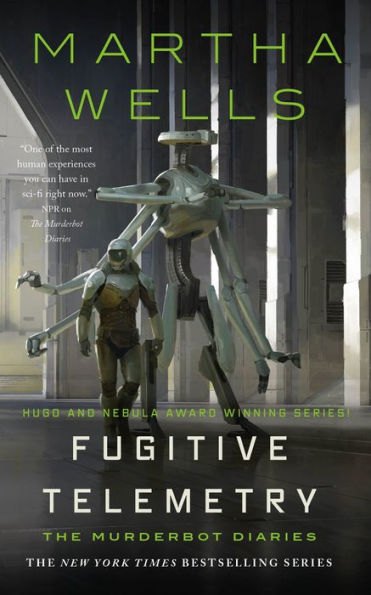

Fugitive Telemetry
Neelix recently obtained a power node from a trader named Oquanii, and the node has a similar configuration to the warhead. They track Oquanii down, and he recognizes the warhead and offers a method of disabling it and taking it off their hands. However, Janeway insists that the weaponry portions of the device not be given to Oquanii. The trader insists on all or nothing, though he does promise not to sell it as a weapon, but rather to break it down into bits and sell the bits, which can be used for other things. Janeway, however, can’t really trust the word of a trader she just met and sends him on his way.
That lack of trust proves wise, as Oquanii immediately fires on Voyager. He tries to punch a transporter beam through the shields to beam the warhead out, but the AI detects that, sends an antimatter surge through the transporter beam, which blows up Oquanii’s ship.
A fleet of three dozen or so warheads of similar design are flying through space. They detect Voyager and head toward it.
The AI demands that Kim and Torres reconstruct some of his memory, as there are still gaps. They do so, and discover that this warhead, its companion, and many others were launched accidentally. The war between the Druoda and the Salinians was over three years ago. They sent a command to disengage, but about thirty-three of them didn’t get the message, apparently. The AI is skeptical, thinking that it’s either Salinian sabotage or Kim and Torres creating false data to save their own lives. The AI also doesn’t see a command authorization code, but Kim points out that it could be in the parts of the warhead’s memory they haven’t reconstructed yet.
Plan B is to use Seven’s nanoprobes to disable the warhead. However, that requires Seven being physically in sickbay. So Janeway has Paris fake going through one of the nearby minefields, with false sensor readings sent to sickbay indicating damage. Seven will be “injured” with plasma burns, and have to be brought to sickbay for treatment. Tuvok will then disrupt the holographic matrix, which won’t last long, but will give Seven enough time to disable the warhead.
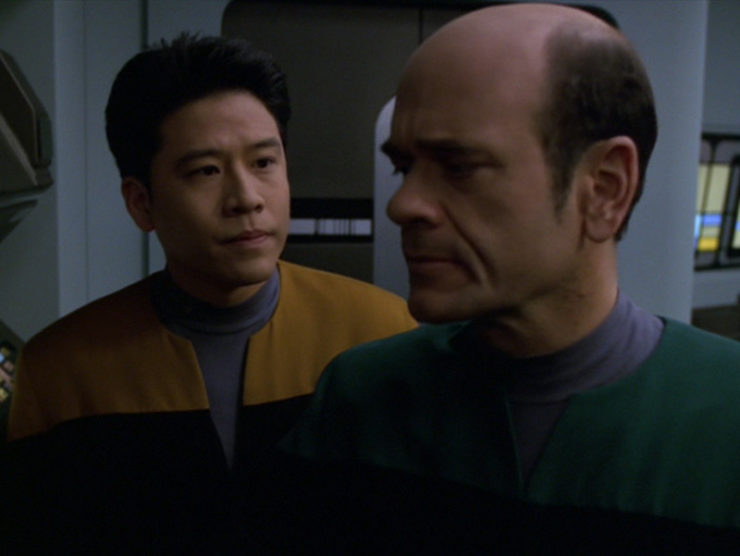
The plan almost works, but the warhead has defenses against attacks like Seven’s, and a feedback loop renders her unconscious. So they go to Plan C, which is Kim pleading for compassion. The AI rejects that notion at first, but Kim points out that it was the EMH’s compassion for it that led to its being brought on board Voyager and getting its memories back. Its mission is to protect people, but all fulfilling this particular mission will do is kill people for no reason.
By the time the AI is convinced by Kim’s pleading, the other thirty-two warheads have caught up to Voyager. Unfortunately, they’re now within two light-years of their target, and the warheads can’t accept any change to their program this close to the target (which is, at once, completely idiotic and completely realistic). The AI realizes that the only way to stop those warheads from destroying the installation on Salina Prime is to be beamed out into space and then detonate, taking the other warheads with it.
Kim expresses sorrow, but the AI says again that its job is to protect people—it’s just the target that’s changed.
After the warheads are all destroyed, we see Kim starting the night shift. Jenkins says thanks, on behalf of the junior staff (of which Kim is one, but never mind). Kim’s reply is to request that there be no distress calls, please.
Can’t we just reverse the polarity? The Durodans have built their warheads with an artificial intelligence for reasons that are never made entirely clear, since they’re pretty much preprogrammed missiles. Then again, this one is explicitly flawed in some way, as it didn’t take to the recall command, so maybe the ones that work right are more versatile.
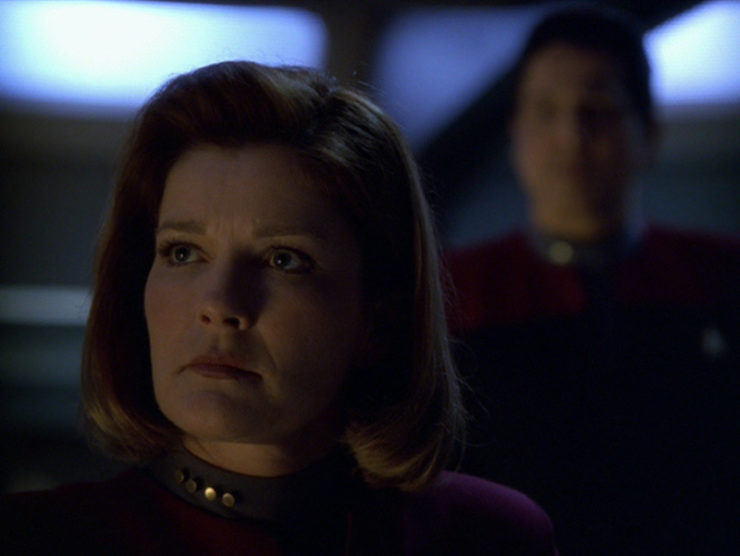
There’s coffee in that nebula! After the attempt to sabotage the warhead fails, the AI instructs Janeway to abandon ship. She refuses. The AI points out that it will destroy the ship, and Janeway very calmly tells him to go ahead. When the AI counters that everyone on the ship will die, Janeway, still very calm, says that yes, but nobody else will. It’s quite the captainly moment.
Forever an ensign. It makes no sense, none, that Kim is still an ensign after five years, yet is still considered “senior staff” and gets to be in charge of the bridge during gamma shift. As a low-ranking officer, he’s as much “junior staff” as Jenkins, and while Jenkins should still be calling him “sir” when he’s watch officer, there’s still not that much of a gap between the two of them in terms of their place on the ship.
The issue here, for the record, isn’t that Kim is in charge of gamma shift, or considered senior staff, it’s that he is still at the same rank he was at five years ago…
Half and half. Torres evinces no interest in engaging the AI in conversation, and does nothing to aid Kim in his attempts to convince the AI that he’s being a big stinky. To be fair, that sort of thing isn’t really in her wheelhouse…
Everybody comes to Neelix’s. Apparently Neelix is skilled enough in makeup to create convincing-looking plasma burns on Seven’s face. Paris jokes that, if he keeps this up, Janeway will promote him to Senior Beautician. (And maybe he will get that title, but he’ll never be the best person to hold that position….)
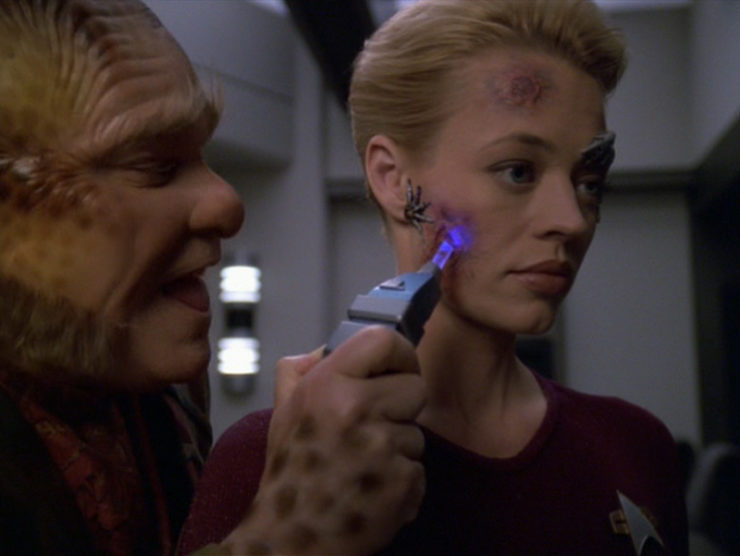
Please state the nature of the medical emergency. The EMH advocates mightily for treating the AI with respect and compassion, and gets his body taken over for his trouble.
Resistance is futile. It has, at this point, become a cliché that Seven’s nanoprobes keep being the go-to solution for an episode’s problems, so it’s nice to see that it doesn’t actually work here.
No sex, please, we’re Starfleet. Paris totally forgot that it was the anniversary of his and Torres’s first date, and the episode opens with him negotiating with Neelix for a trade of replicator rations to put together a great date night. Of course, Torres spends the evening stuck in sickbay with Kim and a crazed AI…
Do it.
“Helm, status?”
“Same as it was twenty minutes ago.”
“Refresh my memory.”
“Current speed warp 6.3, heading 021 mark 2. Permission to speak freely, sir?”
“Granted.”
“We’re on the night shift—relax!”
“One of these days you’ll get the call to take the bridge, and maybe then you’ll understand the burden of command.”
–Banter between a pretentious Kim and an exasperated Jenkins.
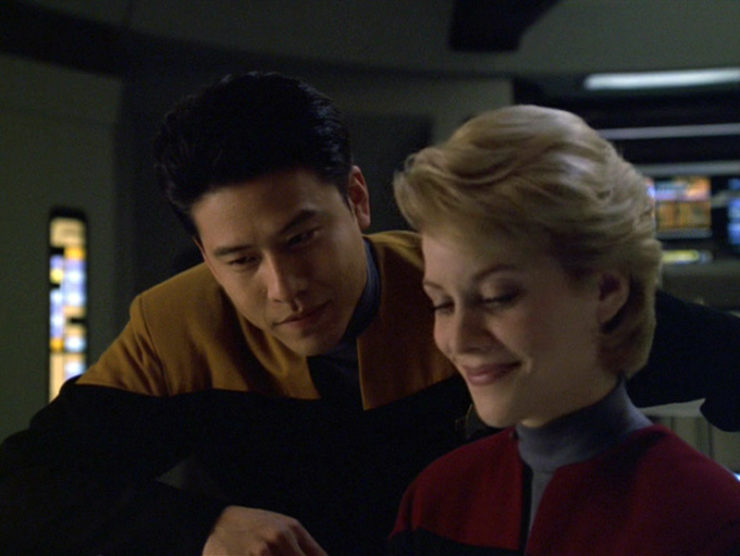
Welcome aboard. McKenzie Westmore plays Jenkins. She previously played one of the little girls in TNG’s “When the Bough Breaks,” and will later play a background alien in Picard’s “Maps and Legends.”
Steve Dennis plays Onquanii, his third of four appearances in this season of Voyager. He previously played one of the aliens in “Night” and Fennim in “Think Tank.” He’ll be back in the next two episodes (the “Equinox” two-parter) as Thompson (his only Trek role involving no makeup), and also play an Andorian in Enterprise’s “The Andorian Incident” and “Shadows of P’Jem.”
And regular extra Sylvester Foster gets a name for his character: Lang.
Trivial matters: This episode was inspired by Brannon Braga watching an episode of Frontline about the huge stockpile of nuclear warheads just laying around in the former Soviet Union that were, in essence, up for grabs.
The EMH’s built-in translation matrix was established in “Gravity.” The process of downloading the AI into a holographic matrix is similar to what was done with Denara Pel in “Lifesigns” and the re-creation of Crell Moset in “Nothing Human.”
McKenzie Westmore, who played Jenkins, is part of the Westmore family of Trek production folk, most of whom are involved in makeup and such: her father Michael, her brother Michael Jr., her uncle Monty, and her aunt June. Her great-aunt, Patricia Westmore, was the hair stylist on the original series. The character of Jenkins also appears in the alternate timeline of Places of Exile by regular commenter Christopher L. Bennett in Myriad Universes: Infinity’s Prism. She’s given the first name of Tricia, after the actor’s great-aunt.
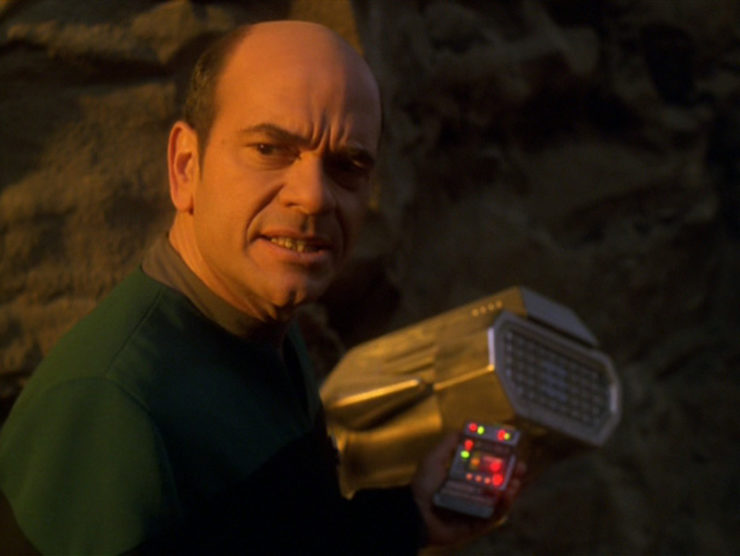
Set a course for home. “We’re going to find a way to outsmart a smart bomb.” In some ways, this is the same story as “Dreadnought,” except it’s Kim arguing with someone using the EMH’s voice instead of Torres arguing with someone using her own voice, but the episode works on its own for several reasons.
For starters, it’s a very Star Trek story, as it isn’t technobabble trickery or superior firepower that wins the day, but an argument for compassion and common sense over blindly following orders.
It’s fascinating that this story was inspired by a post-Cold War news story about all the excess warheads floating around Eastern Europe, because what this reminded me most of was two 1964 Cold War films. Fail Safe and Dr. Strangelove, or, How I Learned to Stop Worrying and Love the Bomb are two movies that are diametrically opposed in tone but have the exact same plot: something goes horribly wrong and American bombers are sent to attack the Soviet Union even though there’s no active state of war.
And that’s what happens here, too, with the main change being that the catastrophe is averted. Where the 1964 movies are about the tyranny of preprogrammed instructions, the AI in the warhead is able to think through the problem, goosed by an impressively eloquent Harry Kim, and then perform a noble act of self-sacrifice for the greater good. Which is what it was programmed to do in the first place, of course—as the AI itself says, it’s just got a different target for the same mission.
Both Robert Picardo and Garrett Wang shine here. Kim’s pretentious goofiness as he struts across the bridge all large and in charge is ridiculous, but it serves as a nice prelude to a proper command situation. And unlike so many other mediocre attempts to show how Kim has matured that the show has stumbled through over the years with varying levels of success (“Emanations,” “Non Sequitur,” “The Thaw,” “The Chute,” “Alter Ego,” “Favorite Son,” “Demon,” “Timeless,” “The Disease”), this one actually feels earned and legitimate. And it truly builds on Kim’s previous experiences as a bridge officer on a starship for five years, showing what he’s learned.
And man, Picardo is stupendous. I was worried that he’d devolve into stereotypical EEEEEEEEEEEEEEEEE-vil like he did in “Darkling,” but instead he gives us a hard, stubborn, determined, single-minded intelligence that refuses to deviate from what he’s been programmed to do. It’s an intense, impressive performance, latest in a series of bits of brilliance from Picardo.
Not to be outdone is Kate Mulgrew’s quiet confidence as she tells the AI to go jump in a lake. She plays along with the AI’s instructions at first to keep her crew safe, but as time starts to run out, she makes it abundantly clear that she’ll sacrifice the ship and crew to keep them from being used as a weapon of war against their will.
Warp factor rating: 9
Keith R.A. DeCandido is also reviewing each new episode of The Falcon and the Winter Soldier as they’re released on this site.











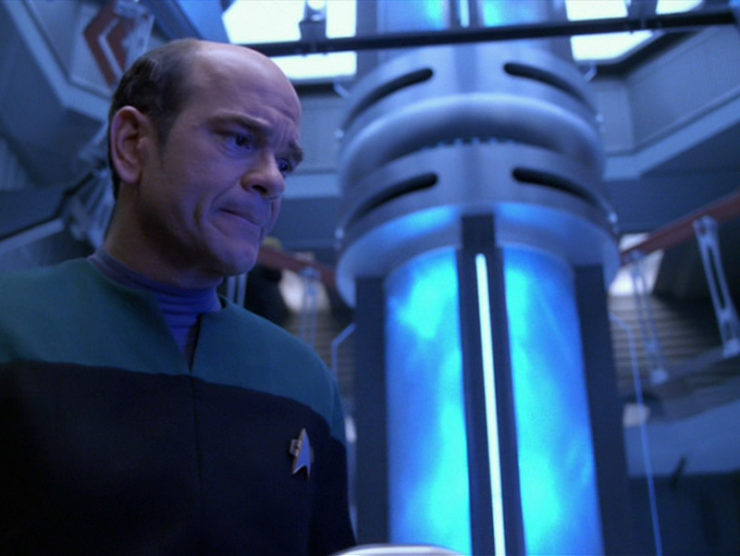
You have to talk to the bomb, Doolittle. Teach it… phenomenology.
A follow-up to the “loose warheads in the former USSR” stories, at The Atlantic: The Bombs That Never Went Off
IIRC, Fail Safe and Dr. Strangelove are based on the same novel…
Well-played, Patrick, well-played…..
—Keith R.A. DeCandido
wiredog: Not quite. Fail Safe was based on the novel of the same name by Eugene Burdick & Harvey Wheeler. Strangelove was based on Red Alert by Peter George.
It was a notion that was on a lot of minds in the 1960s………
—Keith R.A. DeCandido
Wow, I have basically no recollection of this one, except for a couple small scenes.
One thing that always bothers me is why they *have* a “night shift” that is seemingly completely staffed by junior officers. Sure, this makes sense on Earth (or, presumably, on other terrestrial bodies) because military tactics and the likelihood of certain issues cropping up tends to be correlated with different parts of the day-night cycle. But they are in space– where there *is* no day-night cycle (other than the one they’ve created for themselves by dimming the lights), and furthermore they are far away from the Federation, where presumably their ships and stations use a more-or-less “standard” time. “We’re on the night shift—relax!”- is pretty meaningless when, for all you know, every other species in this area considers it to be the middle of the “day,” not to mention that the weird stellar phenomenon that ships in Trek are constantly running into likely don’t keep a 0600-1800 schedule and could cause problems at any time. Also, aren’t there any other command officers who could use some time sitting in the big chair? There are constantly people running around with red uniforms on in the background, why aren’t some of them doing “night shift” command? What’s so special about Ensign Kim other than he’s played by someone who they actually paid to speak?
I understand that the Doylist reason is that they want all the characters in the opening credits to be on-screen at the same time, but from a Watsonian standpoint it doesn’t make a whole lot of sense. Of course, as KRAD points out, if they had just promoted poor Ensign Kim, this whole situation might make a little more sense.
I never understood the sense of the nightshift not being considered important on Voyager as they are constantly warping through unknown (to them) space. You would think they would encounter new stuff on a regular basis. I get what they were going or, story wise, but in unknown space, all shifts should be considered important, I would think. Or maybe I’m overthinking it.
@5 – Yeah, that was a real head-scratcher. I had the exact same thought watching this: “It’s space! There is no day-night cycle!”
Still a really good episode, though. Picardo kills it (again). And I didn’t really think it was that strange that they programmed missiles with AI. That was even addressed in the episode: these are long-range missiles (as in light-years) and there’s all kinds of stuff to navigate in between that requires an intelligence.
I have very little memory of this episode, but I remember not being particularly impressed by it. Perhaps that’s because it features the crew working with an unknown, highly destructive alien technology just a few feet from the warp core. I mean, what is the point of sealing off Engineering with a force field if Engineering is the one part of the ship that you want damaged the least? They do have a science lab set, don’t they? Couldn’t they have put it there?
Back in high school and college, when I was developing the early version of my original science fiction universe, it was considerably more of a Trek knockoff than it ultimately became, centered on starships. But I tried to design the starships in a way that I felt made more sense than what we saw on the shows and movies. One element I included in my starship design was an outboard science lab connected to the rest of the ship by a narrow pylon, so that any dangerous thing investigated there wouldn’t endanger the ship if it released a toxin or blew up or something and so that the whole lab could be easily jettisoned if necessary — an idea I may have originally gotten from TOS: “Court Martial” and its jettisonable ion pod. I may also have been influenced by TNG: “Unnatural Selection,” where they had the good sense to study the potentially infectious genetically-engineered human subject in a shuttlecraft so it wouldn’t endanger the ship. It always frustrated me that later episodes ignored that sensible approach.
Even without a real day-night cycle, people still have circadian rhythms, and I can see having a fake day and night helping people keep their sanity out there. Doesn’t mean it’s any less dangerous in space whatever the time may be, though.
I suppose the real question is how do these various species from various worlds with different lengths of day and different philosophies concerning time and work serve together on the same shift without being at each other’s throats? I mean, no wonder Worf was grumpy all the time. The guy needed a nap!
@10 I always wondered about that! Everyone in my unit is from Earth (obviously), and we still argue about what temperature the thermostat is set at in the office. Is Tuvok freezing all the time? Are the lights too bright for some people? Is the humidity comfortable to everyone? Do the Bajorans keep their regular 26 hour days or is everyone forced to acclimate to Earth time? Are aliens who see outside the human visual spectrum constantly bombarded by light? Almost everything on board is fixed at a certain height, so I guess that very short aliens (or humans, or people of any species in a wheelchair) just kind of have to deal with it? The closest we come to getting those answers is that (spoiler alert) Captain Lorca has to keep self-medicating to prevent his Terran eyes from being over-stimulated, but it makes you wonder why he can’t just… turn the lights down a bit. And obviously Garak doesn’t like the new environmental controls on DS9, but no one else seems bothered by them.
#11
Good point. Andorians come from a cold world. Vulcans come from a hot world. They must be constantly adjusting the environmental controls. It would be like staying with my grandparents, haha.
@11 – I’m sure they can handwave that stuff away. Maybe everyone is walking around with a personal force field, inside of which is the optimal temperature and lighting. I’m mostly sarcastic here, but I wouldn’t put it past the writers…
Day night cycle is an interesting dilemma. With a limited crew, how do you make sure your experts/senior staff are able to work together on important problems without leaving the alternate shift to be led by more junior crew? I suppose the answer is shift rotations, but then that has its own implications on efficiency or mental health…
I didn’t really remember a whole lot of this episode, but I think it’s because I just get it confused with Dreadnought in my head, and I also just enjoy Dreadnought more than this one. Reading the recap, I can see how the episode stands on its own merits, but I struggle to get past the feeling that this concept had already been kind of done before.
The crazy thing about Dr. Strangelove is that the real life Soviets had no intention of announcing their Doomsday device at the party congress on Monday. They still don’t officially acknowledge its existence.
(Because this is the kind of corkscrew thinking that nuclear games theory encourages, the apparent purpose of the Russian Perimeter system, which would not automatically launch missiles but, if certain criteria were met, would skip all the intervening steps of authorization and allow them to be launched by a single guy in a bunker somewhere, was meant to deter the Russian leadership from launching prematurely when they only thought there might be a nuclear threat from the US).
@13/Austin: “Spock’s Brain” established that the uniforms have built-in environmental controls that can keep the wearers warm even in ice-age conditions. Presumably they can be adjusted for comfort aboard ship too. Although of course, that was ignored in later productions like the movies, where they had heavy parkas for landing parties.
@16 – That is true, though I feel like a lot of OS stuff is overlooked or ignored. Maybe the almighty combadge has a built in AC/heater. Speaking of the combadge, how does it know when to stop transmitting? It’s something I saw again in this episode. Somebody responds and then immediately turns to somebody else and starts talking, sometimes even about the bad guy! There’s never any indication to stop transmitting. It’s weird.
Issues of diurnal cycle, ambient temperature, light levels, etc. maybe why starship crews seem to be comprised mainly of one species with a few outliers.
Worf was raised by humans and so presumably acclimated to human preferences. I seem to remember Spock wearing undershirts, as Kirk certainly didn’t, and presumably other non humans on earth ships made similar adjustments.
#18
But Worf had a very rough childhood, which probably would’ve been a lot smoother if someone had allowed him to get his fourteen hours of sleep. I know it works wonders for me!
Data once told Lore that in order to achieve a rank of Lt. Commander he had to spend a number of years on lower positions, citing an average of 3 years as an Ensign among them. If the average is 3 years, that means Kim should have been promoted back in season 3. Even Paris only spent 18 months in this demoted state after disobeying direct orders. Does this mean Kim is a worse officer than Paris? Personally, I don’t think so, but the show has never made an effort to portray Kim as a case of pulling effort above-and-beyond the call of duty either. Voyager may be as episodic as TNG, but it’s still somewhat aware that people go up in rank overtime, given enough work and effort.
Of course, Kim being stuck in a perpetual ensign bubble is very much in synch with the tensions between Garrett Wang and Rick Berman. This leads to self-indulgent scenes such as this bridge gamma shift bit where we’re treated to this display of main castmember inequality, even though Kim and Jenkins are mostly equals. It’s not pleasant when real-life politics and disputes intrude into this fictional universe.
That Harry Kim rant aside, there’s plenty to enjoy about Warhead. It’s very much a remake of Dreadnought, but it’s still executed well. Once again, it puts the EMH in the spotlight and it gives Picardo a chance truly shine, and to stretch beyond his usual self. Plus, I’m glad this doesn’t devolve into the old trope of making the A.I./robot/intelligence self-destruct thanks to the captain’s logical argument creating a loophole. Instead, we get the A.I. making the logical decision to self-sacrifice after assessing the situation with pinpoint accuracy.
It’s the type of story that’s been done before, but it’s a staple of the franchise, and there’s nothing wrong with a retread if you’re going to do it this well. By this point, Braga and the staff were still keeping true to the template set in seasons 3 and 4. That is, this story could have easily been done on either TOS or TNG. It’s not new, but it serves Voyager well, and it’s certainly a step better than the Kazon mistakes from the early seasons.
In hindsight, there’s a bit of an inconsistency that’s related to the EMH’s eventual creation of the ECH directive, but I’ll refrain from addressing that issue until we get to Tinker Tenor Doctor Spy.
A side note: it’s not the first time the movie Fail Safe serves as an inspiration for an episode of Trek. It was also the direct basis for DS9’s Defiant – specifically the scenes with Sisko and Dukat in the Cardassian war room monitoring the Defiant’s course and attacks.
This is another episode that I only caught for the first time fairly recently and I held out for so long because it seemed like such a derivative premise. Having now watched it, I can say it’s competent, but also kind of unmemorable. It also reminds me a lot of the premises of both “Prototype” and “Dreadnought”, both of which were Torres episodes from the second season and I would say more interesting and memorable than this one.
@18/roxana: In the early first season, and again in TMP, Spock’s uniform had a higher collar than those of his crewmates. This was to prevent his Vulcan makeup from smearing on the uniform collar, I think, but I always liked to interpret it as something he wore for warmth before he got sufficiently acclimated (or reacclimated, in TMP) to the ship’s temperature. Although that doesn’t really work now that I think about it, because he’d already served on the ship for over 11 years under Pike.
There was a book on running a chemistry lab that made a similar point. Any experiment or equipment that runs for days on end is actually more likely to blow up outside business hours.
“Asking me to give you a bumpy ride is like asking a virtuoso to sing off-key.”
Not a classic but a decent solid episode. There’s a slight awkwardness around the way that Voyager’s compassion puts lives in danger, injures Seven and gets Onquinaii killed. But ultimately it’s Kim’s appealing to the best in the weapon, and the compassion that he witnesses, that saves the bomb’s innocent target and possibly prevents a war. So I think they can chalk this one up as a win.
And it demonstrates that you actually can write an episode around the lesser featured crewmembers. While Kim’s not exactly moved beyond being the inexperienced junior officer, this one does at least shove him out of his comfort zone and force him to act as though he already is what he aspires to be. Indeed, this episode seems at pains to reduce the role of the heavy-hitters: Janeway and especially Tuvok are notably absent from a number of meetings, giving Chakotay a chance to take centre stage. After featuring heavily in the opening scenes, the Doctor is effectively removed from the action: This does mean Robert Picardo’s reduced to shouting threats to detonate a lot as a rather two-dimensional antagonist, at least until he gets to show the bomb’s change of heart. And most refreshing of all, the episode sets up Seven of Nine and her super-duper nanoprobes as a deux ex machina solution only for it to completely fail to work.
Paris says it’s the anniversary of his first date with B’Elanna: I’m not sure what that refers to, unless it’s that trip to the holodeck at the end of “Displaced”? I made Ensign Jenkins the chief helm officer of the USS Andromeda…then forgot I’d done that and had her filling the role on Voyager not long after. I gave her the first name Sue because it sounded appropriate and only later realised I’d named her after a British actress. Janeway joking about making Kim first officer is rather less funny since Discovery actually did think it made sense to give the job to an underqualified ensign. Similarly, this must be one of the last times someone could use the phrase “weapon of mass destruction” unironically. (Still, they get points for arguing that just because people are soldiers that doesn’t mean they deserve to be bombed on their own soil.) Interesting that Janeway is willing to let the bomb go back to its fellows and mission until Kim reveals they’ve gone rogue: Prime Directive, I guess, since that turns it back into an internal affair.
Curiously, early spoilers for the episode claimed it was the beginning of a three episode arc continuing into the next season. No idea where that came from, because it’s not really got anything to do with the two-parter that follows.
As for Kim’s eternal ensign status, I think it can be at least partly explained by the situation. There seems to be very little point in promoting every ensign on board to lieutenant after three years. If it really was as simple as an automatic promotion after a certain period of time, and the journey really had taken seventy-five years, then they’d all be admirals by the end. I imagine it’s a combination of a qualifying period and there actually needing to be a billet of the next rank up available, either by someone leaving the ship and creating a vacancy or by transferring to another ship that’s a lieutenant short. That said, it feels like this ship loses enough lieutenants that there should have been a spare place for Harry somewhere. (I remember Garrett Wang semi-seriously lobbying for Kim to get the pip Paris had lost.) Maybe he doesn’t fancy switching departments?
(To be honest, the lack of promotions isn’t confined to Harry Kim by any means, and I think it’s only the fact that he’s got such a low rank in the first place that gets the attention. I once made a gag about how several of the Enterprise’s senior staff stayed at lieutenant commander longer than anyone else in Starfleet.)
@16 “Spock’s Brain” established that the uniforms have built-in environmental controls that can keep the wearers warm even in ice-age conditions.
Hmm, it can’t be standard on all uniforms. Only ones which you’d wear when you know you’re going to beam into adverse weather conditions. The uniforms that the crew wore in “The Enemy Within” and “All Our Yesterdays” didn’t help them. (Edit: I originally said “The Naked Time” when I really meant Sulu’s landing party in “The Enemy Within”. But the uniforms worn by the research team stationed on the planet in “The Naked Time” could also have qualified.)
@25/richf: Well, of course “Spock’s Brain” just threw that “temperature control” bit in there so that they wouldn’t have to spend money designing and building cold-weather gear for the landing party. And it’s not as if season 3 was known for its worldbuilding consistency. Still, it’s a neat bit of accidental futurism, and I wish the franchise had remembered it.
As soon as I began to read the recap, I thought of Dark Star (haven’t seen the episode, or can’t recall it).
I’m a little surprised that Seska never planned one of her attacks on Voyager during the night shift. She could’ve made them look 10 times more inept than they already were. I guess maybe she just wanted all the day shift people awake to witness how easily she owned them.
Regarding the night shift thing, apologies ahead of time for bringing my naval experience back into the comments, but in this case I’d wager it’s a valid analogue.
There are two modes of work on a ship. One is watchstanding, on the bridge and in engineering. A conning officer, helmsman, etc. must always be on the bridge to keep the ship going the correct course and speed, and to respond to situations as they arise. And engineers have to be down below keeping the power plant going.
In addition to that, a ship is also a regular workplace, where crew members work 9–5 (or 8–4 or whatever) doing paperwork, maintenance and cleaning, training, etc. Breakfast, lunch, and supper are served at the expected times, and after a certain hour the lights are dimmed in all the passageways throughout the ship.
The night watch (or “shift,” as they call them in Starfleet) would have just as many personnel as the day watch.
Steve Dennis’s reading of the line “That energy matrix is worth a thousand dilithium crystals!” as Onquanii has lived rent-free in my memory for the last two decades.
@ChristopherLBennett already mentioned my first problem with the episode – transporting a dangerous thingie right into engineering. I didn’t want to believe it. :D
The second – why the hell they’ve made no attempts to contact either parties of the war? could have helped to clarify the situation and have more insightful discussion with the bomb maybe…
Otherwise it was a nice episode, but not very original.